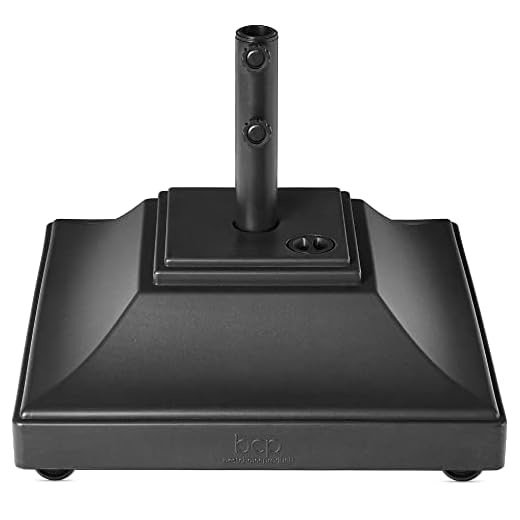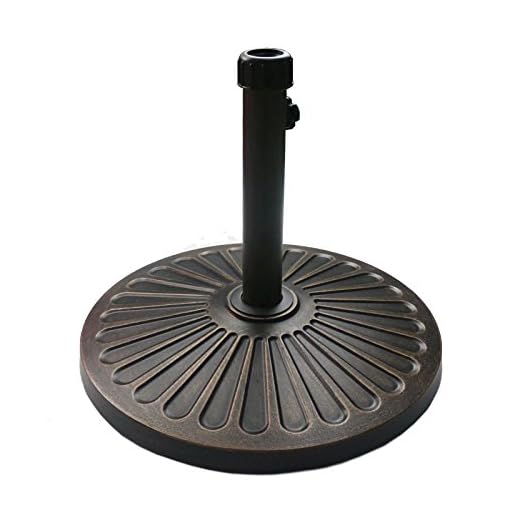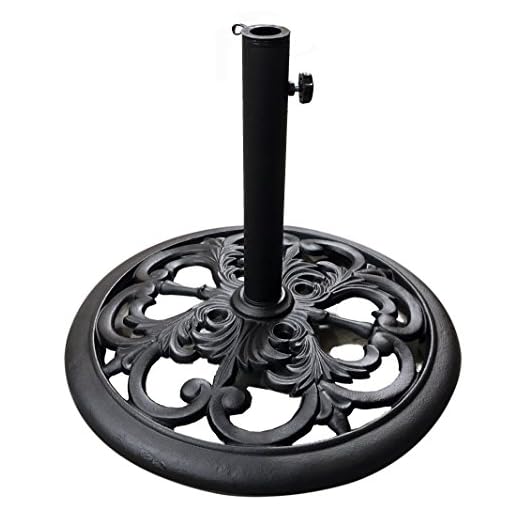



Selecting the appropriate base for your patio canopy can significantly enhance your outdoor experience. This article provides insights into various options available, focusing on durability, stability, and aesthetics. Whether you are a homeowner looking to beautify your garden or a business owner aiming to create an inviting outdoor space, understanding the different types of bases is essential.
In this guide, I will examine the most common materials used for bases, including concrete, plastic, and metal, comparing their benefits and drawbacks. You will learn about the factors to consider when making a choice, such as weight, ease of use, and weather resistance. By the end of this article, you will have clear recommendations tailored to your specific needs, ensuring your canopy remains secure and functional through various weather conditions.
Choosing the Right Material for Your Umbrella Support
Concrete is a highly recommended choice due to its durability and weight. This substance offers excellent stability, preventing tipping during windy conditions. Additionally, concrete can withstand harsh weather without degrading, making it a reliable option for long-term use.
Another option is metal, particularly aluminum or steel. These materials are lightweight yet sturdy, providing adequate support for various sizes of canopies. Aluminum is resistant to rust, while steel offers increased strength but may require a protective coating to prevent corrosion.
Considerations for Selecting the Right Option
When evaluating your choices, consider the following aspects:
- Weight: Heavier options generally provide better stability against strong winds.
- Durability: Materials should withstand exposure to sun, rain, and other elements.
- Maintenance: Easy-to-clean options will save time and effort over the years.
Ultimately, selecting the appropriate support involves balancing weight, durability, and maintenance needs. This approach ensures a safe and functional solution for your shaded area.
Durability and Weather Resistance in Outdoor Umbrella Stands
A well-constructed base for a sunshade must withstand various environmental factors to ensure longevity. The choice of components plays a significant role in maintaining structural integrity over time. Selecting an option that combines robustness and resistance against the elements is essential for outdoor use.
Materials like concrete, steel, and high-density polyethylene offer impressive durability. Concrete provides weight and stability, making it less likely to tip over during strong winds. Steel, often treated with coatings to prevent rust, can endure exposure to moisture and UV rays. High-density polyethylene is lightweight, resistant to fading, and can withstand harsh weather conditions, making it an excellent choice for portability.
Key Factors Influencing Longevity
- Corrosion Resistance: Metal components should be treated or coated to prevent rust and degradation.
- Weight: A heavier base is more stable in windy conditions, reducing the risk of damage.
- UV Resistance: Materials that resist fading and brittleness from sunlight prolong the aesthetic appeal and functional use.
- Moisture Management: Components that can resist water absorption help avoid warping or cracking.
Investing in a high-quality base not only enhances the functionality of your shade solution but also ensures it stands the test of time against various weather conditions. Evaluating options based on these criteria will lead to a more satisfying and long-lasting choice.
Weight Considerations: Finding the Right Balance
Choosing the appropriate weight is fundamental for maintaining stability and safety. A sufficient mass is necessary to withstand gusty winds and prevent tipping. Generally, a weight of at least 50 pounds is advisable for smaller canopies, while larger structures may require upwards of 100 pounds.
It’s essential to consider the type of surface where the base will be placed. For instance, a concrete patio may allow for a lighter weight compared to a grassy area where additional stability is needed. Understanding the local climate and expected weather conditions can also influence the required mass.
Factors to Evaluate
- Wind Resistance: Assessing local wind patterns can guide weight selection. Areas prone to strong gusts necessitate heavier bases.
- Canopy Size: The larger the canopy, the more weight will be required to secure it effectively.
- Material Composition: Different substances have varying weights and resistances. Concrete and metal offer substantial stability, while plastic may be lighter but less durable.
In addition to these factors, it’s beneficial to consider adjustable weights. These allow for customization based on specific needs, enhancing flexibility and convenience. Some bases come with options to add water or sand, providing an adaptable solution for various scenarios.
Ultimately, striking the right balance between weight and functionality ensures a secure and enjoyable outdoor experience. By carefully evaluating the specifics of the space and conditions, one can achieve optimal stability.
Material Aesthetics: Blending with Your Outdoor Decor
Choosing a support for your shade solution involves more than just functionality; it also plays a significant role in the visual coherence of your space. Select a support that complements the existing design elements of your patio or garden, ensuring harmony between the various components.
Consider textures and colors that align with your outdoor furnishings. A support made from wood can add a warm, rustic touch, while a sleek metal option may offer a modern aesthetic. Concrete provides a sturdy, industrial look that can contrast beautifully with softer fabric shades.
Design Integration
When integrating a support into your outdoor decor, pay attention to the following aspects:
- Color Coordination: Choose colors that match or complement your furniture and plant life.
- Texture Harmony: Mix and match textures to create depth. For instance, pair a smooth metal base with woven fabric seating.
- Style Consistency: Maintain a consistent style, whether it be rustic, modern, or coastal, to ensure a cohesive look.
Additionally, consider the scale of the support in relation to your overall arrangement. A bulky support may overwhelm a small space, while a delicate one might get lost in a larger area.
Ultimately, the right choice will enhance your outdoor ambiance, making it an inviting space for relaxation and entertainment.
Maintenance Requirements for Different Stand Materials
Different materials require specific care routines to ensure longevity and aesthetic appeal. Understanding these maintenance needs helps in making an informed choice for your outdoor setup.
Concrete stands demand minimal upkeep, primarily needing occasional cleaning to remove dirt and debris. A simple wash with soap and water can keep the surface looking fresh. However, any cracks should be promptly repaired to prevent further damage.
Wooden Options
Wooden bases enhance the natural aesthetic but require more attention. Regular sealing or staining is essential to protect against moisture and UV damage. Cleaning with a mild detergent and soft brush prevents mold and mildew buildup. Early signs of wear should be treated with appropriate wood care products.
Metal Choices
Metal stands, particularly those made from aluminum or steel, need careful monitoring for rust. A protective coating can inhibit corrosion, while periodic cleaning with a non-abrasive cleaner will maintain their appearance. Inspecting for scratches and applying touch-up paint can prolong life.
Plastic Structures
Plastic bases are lightweight and often resistant to weathering but can fade over time. Cleaning with mild soap and water is sufficient. Avoid harsh chemicals that may degrade the material. Regular inspections for cracks are advisable, as extreme temperatures can cause brittleness.
Summary Table
| Material | Maintenance Requirements |
|---|---|
| Concrete | Occasional cleaning; repair cracks. |
| Wood | Regular sealing; cleaning; treat wear. |
| Metal | Prevent rust; clean regularly; touch-up paint. |
| Plastic | Wash with soap; avoid harsh chemicals; check for cracks. |
By adhering to these specific maintenance guidelines, the longevity and functionality of your choice can be significantly enhanced.
Cost-Effectiveness of Various Umbrella Stand Materials
Choosing the right option for securing a canopy involves considering not just stability but also financial implications. Each substance provides a unique balance between price and durability, impacting long-term value.
Concrete options tend to be robust, offering excellent stability against wind. Their initial cost may be higher, but their longevity can justify the expense. In contrast, plastic varieties are generally more affordable and lightweight, making them easier to move. However, their lifespan can be limited, especially in harsh weather conditions.
Comparison of Different Options
When evaluating choices, it’s essential to weigh both short-term and long-term expenses. Here’s a breakdown:
| Type | Initial Cost | Durability | Maintenance |
|---|---|---|---|
| Concrete | High | Very High | Low |
| Plastic | Low | Medium | Medium |
| Metal | Medium | High | Low |
Considering the table, concrete provides unmatched stability but comes at a premium. Plastic is budget-friendly but may require replacement sooner. Metal offers a good middle ground in terms of both cost and longevity, suitable for moderate conditions.
Ultimately, selecting the right option should align with specific needs, including local weather patterns and how often the setup will be moved. A careful assessment can ensure that the choice made is both economical and practical.
Environmental Impact: Sustainable Choices for Umbrella Supports
Choosing eco-friendly options for your patio or garden accessory not only enhances your outdoor space but also contributes positively to the environment. Selecting stands made from recycled or sustainably sourced materials significantly reduces the carbon footprint associated with production. For instance, products made from reclaimed wood or recycled metals are excellent alternatives that offer durability and aesthetic appeal.
Additionally, consider designs that emphasize longevity and repairability. Investing in quality items that can be maintained and repaired extends their lifespan, reducing waste. Look for suppliers who prioritize sustainable practices in their manufacturing processes, ensuring that every component is ethically sourced and produced.
Eco-Friendly Options
- Recycled Materials: Choose supports made from recycled plastics or metals. These options help divert waste from landfills.
- Sustainable Wood: Look for certified wood from responsibly managed forests, ensuring minimal environmental impact.
- Natural Stone: Durable and long-lasting, stone supports are often sourced locally, reducing transportation emissions.
- Biodegradable Alternatives: Some manufacturers offer biodegradable options that break down at the end of their lifecycle.
Incorporating these eco-conscious choices not only enhances the beauty of your outdoor space but also supports a healthier planet. By prioritizing sustainability in your purchases, you contribute to a more responsible and environmentally-friendly future.
Best material for outdoor umbrella stand
Features
| Part Number | UBP18181-BR |
| Model | UBP18181-BR |
| Warranty | One year warranty on manufacturing defects |
| Color | Bronze |
| Is Adult Product | |
| Release Date | 2024-01-01T00:00:01Z |
| Size | 18-Inch |
Features
| Part Number | SKY5897 |
| Model | SKY5897 |
| Color | Black |
| Size | Set of 1 |
Features
| Part Number | FUB41B |
| Model | FUB41B |
| Color | Black |
| Release Date | 2023-12-22T00:00:01Z |
Features
| Part Number | SKY6685 |
| Model | SKY6685 |
| Color | Black |
| Size | Set of 1 |
Features
| Part Number | UM-BS-1 |
| Model | UB-bronze |
| Color | Bronze |
| Is Adult Product | |
| Size | 14Kg |
Features
| Part Number | 030TSBK |
| Model | 030TSBK |
| Color | Black |
| Size | 20" |
Video:
FAQ:
What is the best material for an outdoor umbrella stand?
The best material for an outdoor umbrella stand typically depends on factors like durability, weight, and weather resistance. Common materials include concrete, metal, and plastic. Concrete stands are heavy and provide excellent stability, making them ideal for windy areas. Metal stands, especially those made from stainless steel or aluminum, offer durability and a sleek appearance but may require more weight for stability. Plastic stands are lightweight and portable but might need to be filled with sand or water to prevent tipping. Ultimately, the choice should align with your specific needs and environmental conditions.
How do I determine the weight needed for my umbrella stand?
The weight needed for an umbrella stand depends on the size of the umbrella and the typical wind conditions in your area. A general rule of thumb is that a stand should weigh about 10 pounds for each foot of umbrella diameter. For example, a 9-foot umbrella would ideally have a stand weighing at least 30-40 pounds. If you live in a windy area, consider using a heavier stand or one that can be filled with sand or water for added stability.
Are there any maintenance tips for outdoor umbrella stands?
Yes, maintaining your outdoor umbrella stand is important for longevity. Depending on the material, you should regularly check for rust on metal stands and apply a protective coating if necessary. For concrete stands, ensure they are not cracking or chipping. Plastic stands can be cleaned with mild soap and water to remove dirt and prevent fading. Additionally, store your stand in a sheltered area during harsh weather to prolong its life.
Can I use a patio table as an umbrella stand?
Yes, many patio tables come with a built-in umbrella hole that can serve as an umbrella stand. Ensure that the table is sturdy enough to support the umbrella and that it is weighted down properly to withstand wind. If your table is lightweight, consider using additional weights or placing it in a protected area to prevent tipping.
What are the advantages of using a heavy umbrella stand?
A heavy umbrella stand offers several advantages. Firstly, it provides greater stability, reducing the risk of the umbrella tipping over in windy conditions. This is particularly important for larger umbrellas. Secondly, a heavy stand can often withstand outdoor wear and tear better than lighter options. Lastly, heavy stands may require less frequent adjustments or repositioning, allowing for more convenient use throughout the season.









